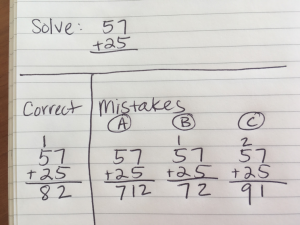Imagine a classroom of 45 students in Liberia. A teacher spends 5 minutes demonstrating 37 + 24 on the blackboard. She then leads students through a 10 minute guided practice of a similar problem, 44 + 19. Finally, students launch into a 25-minute independent practice solving problems aligned to today’s goal. All students work hard, 15 students answer most questions correctly, 15 students do okay, and 15 students answer most questions incorrectly. The teacher circulates while they work in order to give feedback to as many students as possible before the lesson ends.
Most pedagogical experts would recognize this as an instructionally sound, well-aligned 40-minute lesson. After many years of crafting lessons this way, I too believe this is a much more effective approach than status quo lessons in many low and middle-income countries- which is often a teacher lecturing and students copying from the board. However, after studying Direct Instruction (DI) programs, I now think that this Liberia math lesson falls far short of maximizing the impact of 40 minutes worth of instructional time.
Before diving into why most 40 minute lessons are inefficient, let’s revisit the pervasive flaw I wrote about Why Most Textbooks are Broken. From lesson to lesson and chapter to chapter, status quo textbooks move on to new learning goals without ever revisiting the old ones. This fails to leverage the known cognitive benefits of spacing and also risks leaving individual students’ misunderstandings unaddressed. These gaps in learning can then persist and accumulate over time.
The textbook flaw, stated simply is: most lessons are mostly ‘new’ material. DI program scope and sequences fix this by ensuring each learning goal is practiced over a sufficient duration of lessons. The fix stated simply is: most lessons are mostly ‘review.’
But how can we apply this fix without requiring more instructional time for the same number of learning goals or the same amount of instructional time for fewer goals? The answer: we have to let go of the intuitive yet flawed notion that you need an entire 40-minute lesson to practice a single goal.
Let’s go back to our Liberian math class that spent 40 minutes practicing problems like 57 + 25. The problem with this lesson structure is twofold. First, having 25 minutes of a 40-minute lesson devoted to student independently answering say, 15 questions all aligned to the same goal, means that the students who are making mistakes will likely repeat them. Some common mistakes made by students learning to regroup are:

Student A added a place value column where it doesn’t exist.
Student B forgot to add what was regrouped.
Student C reversed the digits to be regrouped.
Students who are incorrectly answering 15 regrouping questions in a row are emblazoning these misunderstandings into their memory. While the 25-minute independent practice is perhaps productive for the 15 students answering correctly and moderately productive for the 15 students doing okay – it’s actively harmful to the students answering most questions incorrectly.
Another inefficiency this lesson structure yields is when students are making a wide variety of errors. It is more difficult for the teacher to respond because she has to figure out a wide variety of diagnoses for why each student answered incorrectly. This can be particularly difficult for novice teachers who are seeing the mistakes for the first time.
Overall, this structure is insufficient for ensuring that each and every student is practicing productively. It also leaves too little time for reviewing old learning goals, which some teachers might try to solve for by inserting a mixed review lesson the day before a cumulative test. Others might insert 5 minutes of review problems at the beginning or end of a 40-minute lesson. Neither of these are sufficient pathways, though, to maximize the full potential of a 40-minute lesson.
The fix: Use one 40 minute lesson to practice several learning goals, most of which are review. A single DI lesson might have 10 different exercises, each one focused on a different learning goal, 8 or 9 of which are review. Part of the benefit of designing instruction in bite-sized chunks of time and spacing out practice of a single goal over the course of many lessons is that it sets the stage to create exercises that are so technically sound and purposefully elegant that the design itself systematically prevents students from making a wide variety of mistakes and deliberately enables teachers to notice very specific details about students’ performance.
DI programs are worth studying in order to see what students are able to do when presented with unambiguous, structured pedagogy. Understanding the details of DI’s approach: how they design a scope and sequence and how they structure individual lessons has helped shed light on pervasive design flaws. While fixing these flaws requires a tremendous amount of technical expertise, identifying them does not.
Solving the global learning crisis inherently requires establishing a clear set of best practices for instructional design. Studying DI Programs and the theory of instruction behind them is a good place to start.
